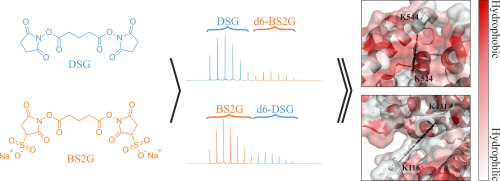当前位置:
X-MOL 学术
›
J. Proteomics
›
论文详情
Our official English website, www.x-mol.net, welcomes your feedback! (Note: you will need to create a separate account there.)
Influence of cross-linker polarity on selectivity towards lysine side chains.
Journal of Proteomics ( IF 3.3 ) Pub Date : 2020-02-20 , DOI: 10.1016/j.jprot.2020.103716 Jan Fiala 1 , Zdeněk Kukačka 2 , Petr Novák 1
Journal of Proteomics ( IF 3.3 ) Pub Date : 2020-02-20 , DOI: 10.1016/j.jprot.2020.103716 Jan Fiala 1 , Zdeněk Kukačka 2 , Petr Novák 1
Affiliation

|
The combination of chemical cross-linking and mass spectrometry is currently a progressive technology for deriving structural information of proteins and protein complexes. In addition, chemical cross-linking is a powerful tool for stabilizing macromolecular complexes for single particle cryo-electron microscopy. Broad pallets of cross-linking chemistry, currently available for the majority of cross-linking experiments, still rely on the amine-reactive N-hydroxysuccinimide esters targeting mainly N-termini and lysine side chains. These cross-linkers are divided into two groups: water soluble and water insoluble; and research teams prefer one or another speculating on the benefits of their choice. However, the effect of cross-linker polarity on the outcome of cross-linking reaction has never been studied. Herein, we use both polar (bis(sulfosuccinimidyl) glutarate) and non-polar (disuccinimidyl glutarate) cross-linkers and systematically investigated the impact of cross-linker hydrophobicity on resulting distance constraints, using bovine serum albumin as a model protein. SIGNIFICANCE: Even though the amine reactive BS2G and DSG cross-linkers have the same length of spacer and are based on N-hydroxysuccinimidic group, our data showed that each of them formed preferentially different cross-links. We demonstrated that the choice of cross-linker can have a significant impact on the output data for structural characterization of biomolecules. Using equimolar mixtures of DSG with d6-BS2G, and BS2G with d6-DSG, we established that the polar BS2G preferentially bound to polar regions of modified molecule, whereas non-polar DSG bound to hydrophobic regions. This phenomenon established that the mixture of polar and non-polar cross-linkers acted as an efficient tool for the determination of distance constraints in proteins.
中文翻译:

交联剂极性对赖氨酸侧链选择性的影响。
化学交联和质谱法的结合目前是用于获得蛋白质和蛋白质复合物的结构信息的进步技术。此外,化学交联是稳定单分子低温电子显微镜大分子复合物的有力工具。当前可用于大多数交联实验的广泛的交联化学托盘,仍然依赖主要针对N-末端和赖氨酸侧链的胺反应性N-羟基琥珀酰亚胺酯。这些交联剂分为两组:水溶性和水不溶性。研究团队更喜欢一个或另一个猜测自己选择的好处。然而,从未研究过交联剂极性对交联反应的结果的影响。在这里 我们同时使用极性(双(磺基琥珀酰亚胺基)戊二酸酯)和非极性(戊二酸二琥珀酰亚胺基)交联剂,并以牛血清白蛋白为模型蛋白,系统地研究了交联剂疏水性对所得距离限制的影响。重要性:即使胺反应性BS2G和DSG交联剂具有相同的间隔基长度,并且基于N-羟基琥珀酰亚胺基团,我们的数据显示它们各自形成优先不同的交联。我们证明了交联剂的选择可能对生物分子结构表征的输出数据产生重大影响。使用DSG与d6-BS2G和BS2G与d6-DSG的等摩尔混合物,我们确定极性BS2G优先结合修饰分子的极性区域,而非极性DSG结合疏水区域。
更新日期:2020-02-20
中文翻译:

交联剂极性对赖氨酸侧链选择性的影响。
化学交联和质谱法的结合目前是用于获得蛋白质和蛋白质复合物的结构信息的进步技术。此外,化学交联是稳定单分子低温电子显微镜大分子复合物的有力工具。当前可用于大多数交联实验的广泛的交联化学托盘,仍然依赖主要针对N-末端和赖氨酸侧链的胺反应性N-羟基琥珀酰亚胺酯。这些交联剂分为两组:水溶性和水不溶性。研究团队更喜欢一个或另一个猜测自己选择的好处。然而,从未研究过交联剂极性对交联反应的结果的影响。在这里 我们同时使用极性(双(磺基琥珀酰亚胺基)戊二酸酯)和非极性(戊二酸二琥珀酰亚胺基)交联剂,并以牛血清白蛋白为模型蛋白,系统地研究了交联剂疏水性对所得距离限制的影响。重要性:即使胺反应性BS2G和DSG交联剂具有相同的间隔基长度,并且基于N-羟基琥珀酰亚胺基团,我们的数据显示它们各自形成优先不同的交联。我们证明了交联剂的选择可能对生物分子结构表征的输出数据产生重大影响。使用DSG与d6-BS2G和BS2G与d6-DSG的等摩尔混合物,我们确定极性BS2G优先结合修饰分子的极性区域,而非极性DSG结合疏水区域。



























 京公网安备 11010802027423号
京公网安备 11010802027423号